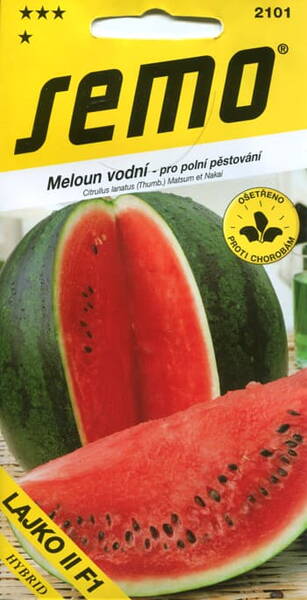From sowing to the start of harvesting 115-120 days. The pulp is bright red, firm, sweet. Excellent taste.
1,0 g = 9-12 seemet.

* An effective method for obtaining early watermelon production is the seedling method.
Thanks to the jump in plant development obtained when growing seedlings this way, you can collect the first fruits 10-20 days earlier than when sowing seeds in the ground. At the same time, the early harvest increases several times, and the overall fruit yield increases significantly.
Watermelon seedlings are grown in semi-warm, early greenhouses or film greenhouses as a second crop after green vegetable crops or early cabbage seedlings. Can be grown at home - in a room on windowsills and balconies.
Seedlings are grown in nutrient pots, the same composition as for vegetable crops, in paper cups measuring 8x8 or 10x10 cm. The age of seedlings is 30-35 days (from emergence). Before planting, seedlings are watered abundantly, water is added to the holes when planting seedlings. It is planted according to the same scheme as when sowing seeds in the ground. Subsequent care for planted plants is the same as for sown ones.
Harvesting fruits.
Watermelon fruits are usually harvested as they ripen. At the same time, fruits intended for transportation over long distances are harvested several days before full ripening, and fruits used at the place of production and seed fruits - in the phase of full ripening. The last, continuous collection of ripe fruits contributes to better growth and ripening of the remaining fruits. Therefore, it is impossible to be late (as well as to rush) with harvesting fruits.
Experienced melon growers determine the ripeness of watermelon fruits visually by their appearance. When ripening, watermelon fruits acquire a characteristic shine and elasticity of the bark for each variety, clarity of the color of the bark and the pattern on it, form a yellow spot on the section of bark lying on the ground, the stalk and tendril near it dry out when the fruit ripens, when you hit a ripe fruit with a palm or click it gives a dull sound, and when squeezing (which is not recommended), you can hear the crackling of the pulp ...
Placement of crops.
Watermelon (as well as other melons) gives the best results when sown on virgin and fallow lands or after perennial grasses, which are the best predecessors for them. In household plots and collective gardens (especially in areas with insufficient heat), areas well heated by the sun, with a southern, south-eastern or south-western slope are selected for watermelon. It can also be grown in greenhouse areas and in the aisles of young gardens that are not shaded by garden plantings.
Use of fertilizers.
The most effective combination is mineral and organic fertilizers. Of the organics, it is best to add last year's rotted manure or humus to watermelon.
Fresh manure, especially in large doses, worsens the taste of the fruit and weakens the plant's resistance to disease. It is advisable to add it to watermelon only in the northern cultivation areas in small areas, where it is used not so much as a fertilizer as to insulate the soil and enrich the soil and air with carbon dioxide, i.e. to improve the microclimate. In this case, manure is added in the spring to pre-made furrows or holes (steam), then covered with soil in a layer of 10-15 cm, and in steam pits - 15-20 cm.
Watermelon seeds are sown on the side along the furrows or in the middle of the steam pit. You can make ridges 210 - 270 cm wide, add manure and dig it into a furrow in the middle of the ridge (alongside) and sow two rows of watermelon on the ridge on the sides of the furrow with the manure. The width between rows on the ridge is 70-90 cm, and between rows on adjacent ridges 140-180 cm.
The consumption of manure when using these techniques is at the level of approximately 6-8 kg per 1 sq. meter. Of the mineral fertilizers, it is best to add superphosphate, ammonium nitrate and potassium salt under the watermelon. It is necessary to take into account that an excessive amount of nitrogen fertilizers negatively affects the taste and dietary qualities of watermelon fruits, in particular, leads to the accumulation of nitrates harmful to humans. Therefore, you should not abuse the use of nitrogen, and other types of fertilizers, especially during the fruiting period.
It is unlikely that there is a person who will say that he does not like watermelons...
This giant berry has become a favorite of everyone. In the season when the harvest is ripe, many even use a watermelon diet to cleanse the kidneys and urinary tract, which is really effective.
But few people know that this fruit has other healing properties. For example, it is rich in iron, and therefore helps with anemia. The increased content of easily digestible sugars makes it useful for diabetes.
For the treatment of liver and gallbladder diseases, including cirrhosis, Botkin's disease, atherosclerosis, hypertension, gout, gastritis, constipation, arrhythmia, coronary insufficiency, tonsillitis, obesity and various intoxications, it is recommended to include 2-2.5 kg of fresh watermelon pulp in the daily diet. For general cleansing of the body, in the absence of contraindications, watermelon fasting is used, when only watermelons and rye bread are consumed for 3-4 days.
Intensive excretion of urine during these days flushes the kidneys and urinary tract, removing grains of sand and small stones.
Not only the pulp of watermelon is medicinal, but also the seeds and rind. They can be prepared for future use and used for the same diseases as the pulp, in the form of decoctions and infusions.
So, for gastritis, 100 g of dry rinds should be poured with 0.5 liters of boiling water and infused until completely cooled. It is better to do this in a thermos. Adults with an average weight of 70-75 kg are recommended to take 100-125 ml of infusion 4-6 times a day. Reduce the children's dosage in proportion to the child's weight. For cholelithiasis and to cleanse the bile ducts, pour 150-170 g of dry rinds with a liter of boiling water, put on low heat and boil for 25-30 minutes. Take the decoction 200 ml before meals 3-5 times a day. Eating watermelon pulp in large quantities is contraindicated in renal failure, exacerbation of gastric ulcer, duodenal ulcer.













